Palm trees are usually a breeze to take care of, growing quickly and rarely giving you any insect or disease headaches. Healthy palms are naturally resilient, but sometimes they can still fall victim to common problems.
Is your palm tree dying and you don’t know what to do? Here are some telltale signs that your palm might need some TLC: leaves that are spotted, discolored, or frizzled; new shoots that are looking a bit wonky; leaves that are drooping, turning yellow, brown, or even black; or an unpleasant odor coming from the trunk or the bud.
Keep in mind, that it’s normal for the older palm fronds to turn brown, dry out, and die since they are being replaced with the new growth. However, if you’re seeing a lot of brown or yellow leaves, that’s a different story.
Why Is My Palm Tree Dying?
Well, before you jump into rescue mode, you’ve got to play detective and figure out what’s causing the trouble.
It could be your day-to-day care routine, a lack of nutrients, the weather, a pesky disease, some unwanted insect guests, or even a previous injury. Most folks dive straight into saving the day without understanding the “why” part.
They start snipping away at the sad and sickly leaves, dump some fertilizer in the soil, and crank up the watering.
And if that doesn’t do the trick, they go all out and transplant the palm to a new spot with better soil. But here’s the thing: all these moves can actually stress out your palm even more and make it weaker.
So, here’s the game plan: first, take a good look at your everyday palm care routine, and then let’s talk about the next steps. In this post, I’ve got 30 of the most common palm problems and how to tackle them.
But remember, an established palm tree will face different issues than a newbie in the ground. So, keep that in mind as you dive into the palm-saving adventure.
Newly Planted Outdoor Palm Tree Exhibiting Brown, Yellow, or Drooping Leaves
It’s quite common for a newly planted palm to experience something known as “transplant shock.” This happens when its roots get shaken up and exposed to the elements, like air and sunlight. When you relocate a palm tree, it loses a good chunk of its roots, which can lead to some water loss in its leaves.
So, don’t fret if your freshly planted palm is rocking brown, yellow, or droopy leaves; it’s just part of the recovery process. It might also be adapting to new light levels, humidity, and temperatures. Here’s the plan:
- Keep that palm well-watered.
- Hold off on the fertilizers for now.
- Resist the urge to trim those ailing leaves until they’re completely dried out because palms recycle nutrients from the old leaves to fuel new growth.
- Check the drainage. If your palm’s leaves are drooping, it could be an indication of poor drainage. Take a closer look at your soil. Did you use a specific soil mix when you planted the palm? Ensuring proper drainage is crucial for the health of your palm tree.
- Check the depth. If after a few weeks, it’s still not doing well, it might have been planted too deep. If the root ball has dropped, you might have left air pockets in the soil when backfilling the hole. And now the palm is sitting too deep. You will need to re-plant it.
- If the tree was damaged during planting, spray it with Copper Fungicide to prevent fungi and bacteria from developing.
- If it’s still not bouncing back, inspect the leaves and the bud (the spot where new leaves sprout) for any signs of insects or diseases. I’ve got treatments for both down below.
Established Outdoor Palm Tree Exhibiting Yellow, Brown, or Drooping Leaves
When it comes to established palms, we can quickly rule out a bunch of issues. These hardy trees have been holding their own in the same spot for a while, so we can safely say it’s not about getting used to the light levels, drainage, soil quality, planting depth, sunburn, or wrong climate.
For an established palm to start looking different, it’s usually a more serious problem. The primary reasons often include:
- Insufficient watering: Take a peek at the soil moisture levels; maybe your palm is feeling a bit dry.
- Nutrient deficiency: The next common problem is a lack of nutrients. Have you been feeding your palm regularly? Check those nutrient levels to see if anything’s running low.
- Cold damage: Did the winter bring any freezing temperatures that might have caused damage?
- Insects or diseases: Normally, only stressed-out palms fall victim to bugs and diseases. Examine the leaves and the bud for any signs of unwelcome visitors like pests or fungi.
30 Reasons Your Palm Tree is Dying and How to Save It Fast
When pinpointing the problem, I suggest starting with a thorough evaluation of your everyday palm tree care routine. If that doesn’t resolve the issue, move on to the next topic, make the necessary adjustments, and observe how your plant responds.
1. Over-Watering
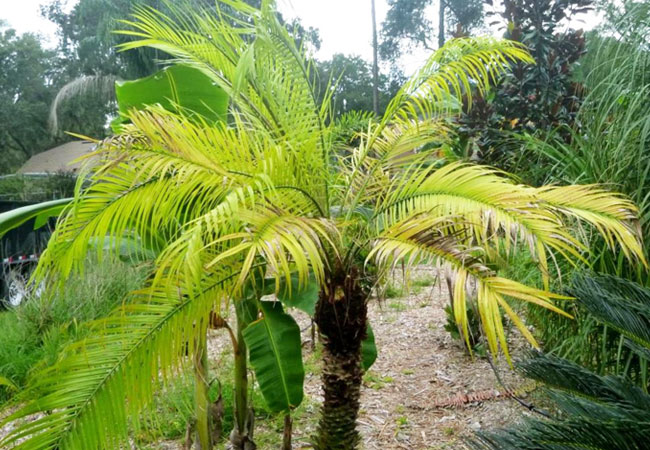
The first sign of over-watering is yellow or brown leaves that fall off before they have a chance to dry. It’s crucial to identify the type of palm you have, as different varieties have varying water requirements.
As a general rule, palms require more water during their growth season in the summer and less in the winter. They prefer soil that’s consistently moist but well-drained. To tackle this issue, consider adding 30% sand to the soil to improve drainage.
2. Not Enough Water
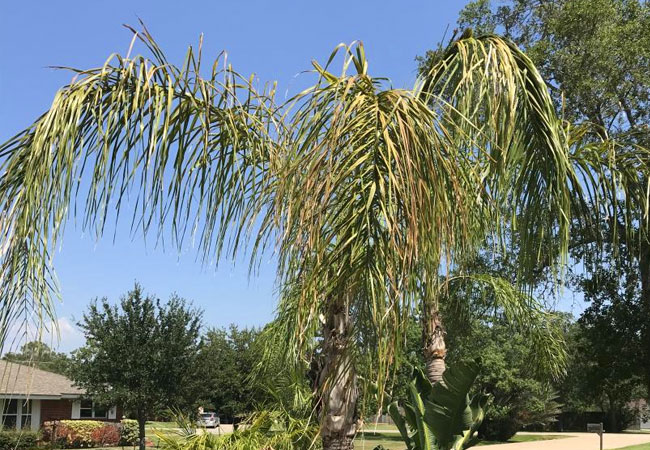
When your palm isn’t getting enough water, you’ll notice the tips of its leaves drying out and turning brown. To check the moisture level of the soil, inspect it the day after watering. You can gauge soil moisture by inserting your fingers about 3 inches into the soil.
Alternatively, you can use an electronic soil moisture meter, which I highly recommend—it provides accurate and easy-to-read results. If it indicates that the soil is too dry, increase the frequency of your watering.
During hot, dry seasons, employing the deep watering technique is most effective. Rather than dousing the palm with a lot of water all at once, gradually drip it over an extended period.
This allows the roots more time to absorb the moisture. This technique is especially crucial for newly planted palms that haven’t established a strong root system yet.
If possible, consider installing a sprinkler system and setting it on a schedule. This way, you won’t need to constantly monitor watering. For further insights and watering tips, check out my article on palm tree watering.
3. Planting Too Deep
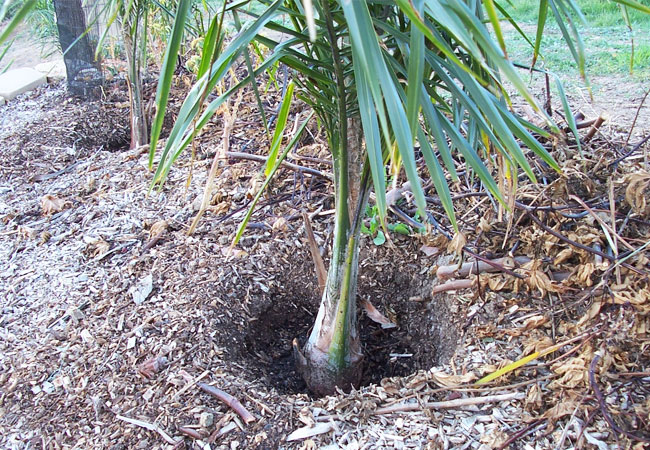
This issue mainly concerns newly planted palms. When you’re putting a palm in the ground, it’s crucial to ensure it’s at the same depth as it was grown before. Planting it too deep can lead to nutrient and water deprivation.
You’ll notice the top of the palm looking sparse and thin. If you realize you’ve planted it too deep, your best bet is to replant it. If that’s not an option, carefully remove some soil from the top. For detailed planting instructions, check out my article on palm tree planting.
4. Poor Soil
Again, this applies more to newly planted palms. If you’ve had this palm for a while, and it’s been thriving, then soil might not be the issue. Good soil should retain adequate moisture while providing excellent drainage.
Soil with poor drainage can harm the roots and lead to root rot. You might spot yellow or dark brown markings on the leaflets, and the new leaf spear may become discolored and wilted.
First, give it a spray with Copper Fungicide to stave off bacteria and fungi. Then, work on improving the plant’s drainage. To avoid this problem, I recommend enhancing drainage before planting the palm. Conduct a drainage test to assess your soil type.
If water doesn’t drain well, you can improve it by drilling holes in the ground, adding rocks to the bottom of the hole, mixing sand into the soil, or installing a drainage pipe to redirect excess water away from the tree.
Try to pair your palm with other plants that share similar water requirements. Also, avoid using soil mixed with fertilizer, as it could potentially harm the roots.
5. Not Enough Sunlight
When your palm craves more sunlight, its leaves will start turning brown. Established palms that have been growing in the shade for some time have already adapted and won’t demand additional light.
This concern is more relevant to newly planted palms. Check the palm’s specifications for its light requirements; you may need to consider replanting it to a sunnier spot.
6. Sunburn
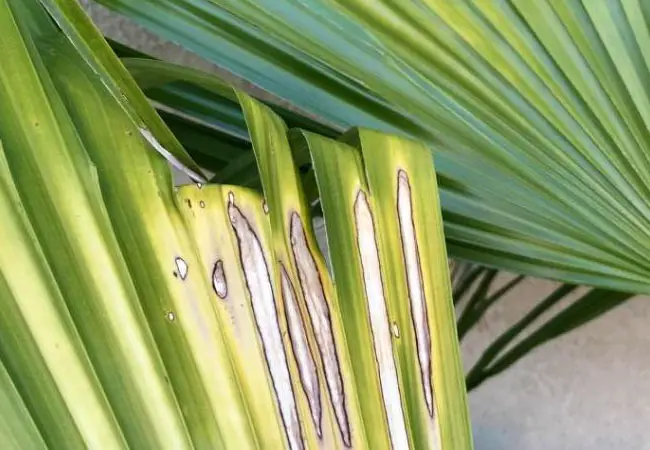
While some palms thrive in full sun, planting a young tree directly in the full sun can lead to sunburn. Signs of sunburn include palm leaves turning yellow and developing colorless areas.
To prevent sunburn, acclimatize the palm first. Here are a couple of methods to do so: If it’s a new palm still in a pot, place the pot in a shaded area initially and gradually increase the exposure to sunlight every week by moving it closer to a sunnier spot.
Another method is to plant the palm in full sun and use a plastic cover above it. You can use four sticks to hold the plastic in place. Each week, increase the light exposure by creating more holes in the plastic.
7. Nutrient Deficiency
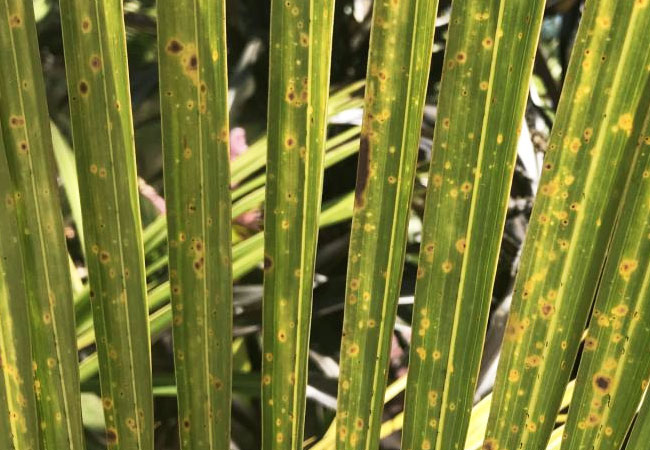
Providing your palm with all the necessary nutrients is crucial for healthy growth and disease resistance.
- If you notice small yellow, orange, or bronze spots covering nearly the entire blade of the palm leaves, it’s a sign of potassium deficiency. Use a slow-release potassium fertilizer and a magnesium fertilizer to maintain soil balance.
- Stunted and deformed leaves may indicate a calcium deficiency, which can be corrected with Calcium Nitrate.
- If your leaves have yellow bands running along the borders, it’s a sign of magnesium deficiency. Correct this with magnesium fertilizer spikes.
- Iron deficiency shows up as leaves with thin green veins, green spotting, and broken ends. This could be due to waterlogging if the palm was planted too deep. Temporarily, you can address this by applying iron fertilizer, but for a permanent solution, consider replanting the palm.
Fertilize palms only during the growth period, about 4-5 times a year (depending on the formula). Avoid using cheap, low-quality fertilizers as they tend to be less effective.
Invest in high-quality fertilizer with a slow-release formula that won’t wash away after a few rains. In my article on fertilizing palm trees, I discuss the best times for fertilization and list the top 5 palm fertilizers you should consider.
8. Fertilizer Burn
Be cautious with fertilizer application, as it can easily burn the palm trunk if applied too closely. Maintain a distance of at least 2 feet. Using soil mixed with fertilizer can also harm the roots. Once the palm is damaged, it becomes more susceptible to diseases, fungi, and insects.
If this occurs, protect your palm by spraying it with Copper Fungicide, which is effective against fungi and bacteria. If the damage isn’t severe, the palm should recover.
9. Over-Pruning
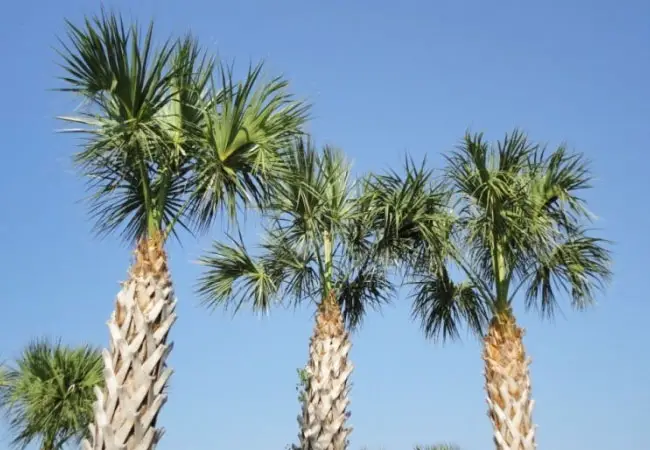
We all dream of having lush green palms without a hint of brown leaves. So, many gardeners start trimming their palms at the first sight of a brown tip. Over-pruning is a common issue.
Here’s the scoop: Palms are smart. They move nutrients from dying leaves to fuel new growth. Cutting off those leaves prematurely means losing those precious nutrients. Don’t snip those leaves until they’re completely dry. Plus, trimming certain palm fronds can halt new growth on that particular frond.
I stumbled upon some articles online suggesting that cutting brown tips can save palms from wasting nutrients on dying fronds. Big mistake! If your palm tree starts looking like it has a rooster tail, you’ve over-pruned it.
10. Hurricane Pruning
Some so-called professionals ((who probably don’t have enough work) might advise you to trim your palm before hurricane season to reduce the weight.
Please resist the urge. Your palm needs all the protection it can get from the wind. Whacking off too many green fronds will stress the palm out.
If you know a hurricane is headed your way, it’s better to tie the fronds together. Avoid pruning any fronds that hang above the horizontal plane of the crown.
11. Wrong Climate
An essential factor for a palm’s success is how much cold weather it’ll endure during winter. Always check the cold hardiness zone before getting a palm tree.
Not all palms can handle cold temperatures. If you live in a chilly climate, opt for one of those cold-hardy palms.
Another challenge can be humidity. Most palms adore high humidity, which can make them tricky to grow in dry conditions.
Before bringing home a palm, check its requirements and drought tolerance if you live in a dry climate.
12. Freeze Damage
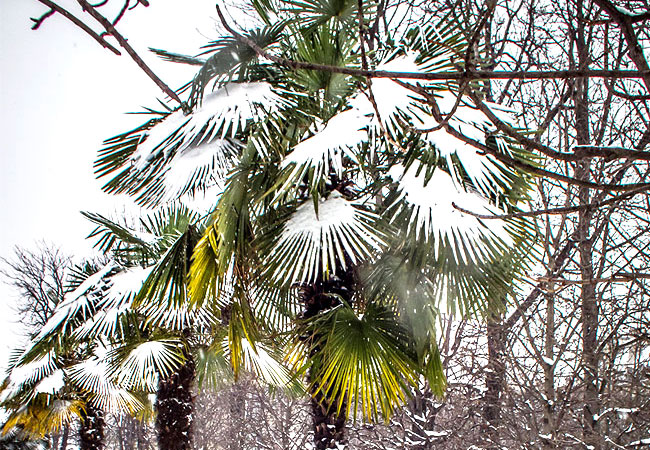
In recent years, even warm climates like Florida have experienced some brutally cold winters with temperatures plummeting below freezing. This chill has taken a toll on many palm trees.
Signs of cold damage can include wilting palms, crowns flopping over due to internal trunk rot, soft lesions on the outside of the trunk, and newly emerged leaves falling around the trunk.
When palm trees suffer from cold damage, they become susceptible to bacterial and fungal infections. To shield them from these pesky microorganisms, give them a good spray-down with Copper Fungicide. Sometimes, though, the damage is so severe that there’s little hope for rescue.
If you’re anticipating freezing temperatures, take precautions in advance. Check out my article on “10 Ways To Protect Palm Trees From Winter Freeze” for techniques to safeguard your palms. And remember, don’t fertilize a cold-damaged palm; it’ll only stress it out more.
13. Trunk Injury
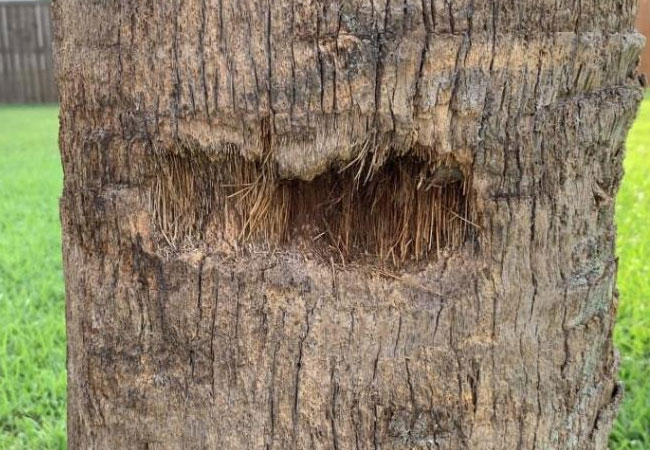
The palm tree’s bark can easily get damaged, leaving it vulnerable to insects and fungus. It’s not always easy to spot this damage right away, and diagnosis can be a bit tricky. Be extra cautious when transporting your palm.
Between the time you purchase the palm and when you plant it, ensure that the root ball stays moist but not soaking. Ideally, aim to plant your tree shortly after purchase.
If your palm comes in a plastic pot, don’t yank the palm tree out of it. Instead, make sure the soil is dry, and carefully cut the plastic pot away with a knife or scissors.
14. Lightning
Believe it or not, there have been cases where palms have been struck by lightning. When this happens, the leaves turn brown and start wilting. Skip the fertilizer, but do keep up with watering.
A palm damaged by lightning is at risk of bacterial and fungal infections. To guard against these threats, give it a good spray with Copper Fungicide.
However, if the palm’s bud was severely damaged by the lightning strike, it’s unlikely to survive.
15. Herbicide Toxicity
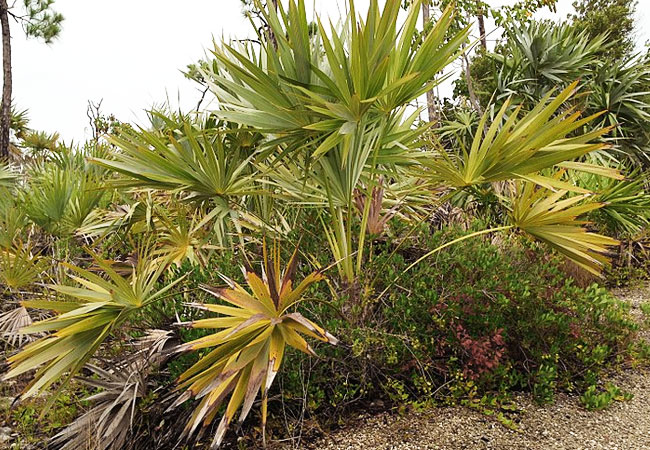
You might not give much thought to herbicide toxicity, but the damage it causes can take months to show. Some signs of herbicide injury closely resemble freeze damage, making it tricky to spot.
Look out for under-sized, deformed new growth with patches of dead tissue on the leaves. Take extra care when using various types of weed killers around your palms.
16. Leaf Spots
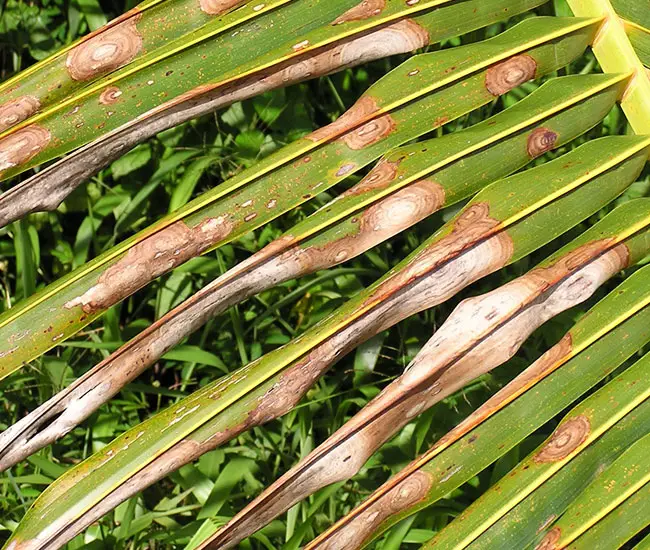
When a nutrient-deficient palm is stressed, it can fall prey to leaf-spotting fungi, which manifests as brown and yellow spots on the leaflets.
This condition often affects palms under stress from overwatering or poor drainage. Whether it’s a nutrient deficiency or drainage issue, address the underlying stress first.
Avoid getting water on the foliage while watering the palm. In most cases, the leaf spots will disappear without needing fungicide treatment.
In severe cases, you may need to spray the affected area with fungicidal sprays containing copper hydroxide or copper salts of fatty acids.
17. Lethal Yellowing
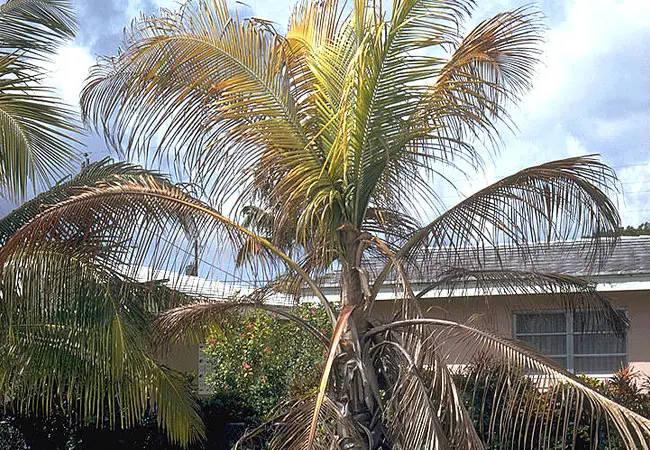
Lethal Yellowing is a deadly disease transmitted by an insect called Myndus crudus. Signs include blackening on the fruit stems, premature fruit dropping, and blackening of new flowers.
Old fronds may turn grey, yellow, or brown, eventually leading to the entire crown falling off. Unfortunately, there’s no cure for Lethal Yellowing disease.
The best course of action is to remove the infected palm to prevent its spread to other plants.
18. Bacterial Bud Rot
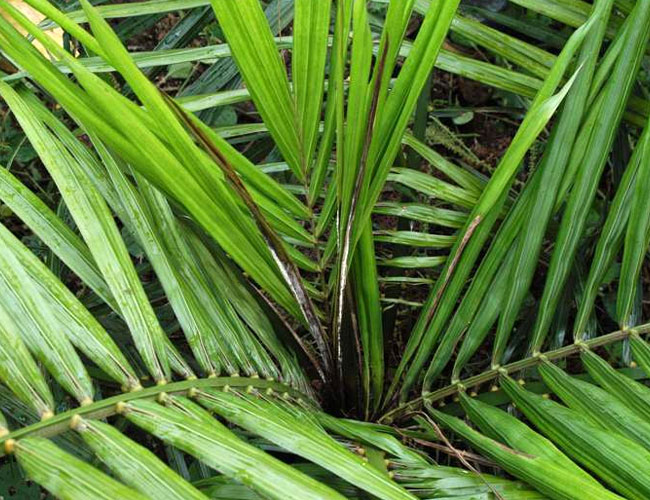
Cold-damaged palms can fall victim to bacterial bud rot disease. Keep an eye out for a discolored and wilting new leaf spear. The affected leaf spear may easily pull away from the bud, and a foul odor can also be an indicator of the problem.
As with many other diseases, drenching the affected area with copper-based fungicides can help eliminate it. That’s one of the reasons why I always recommend applying copper-based fungicides before the cold snap.
19. Fusarium Wilt
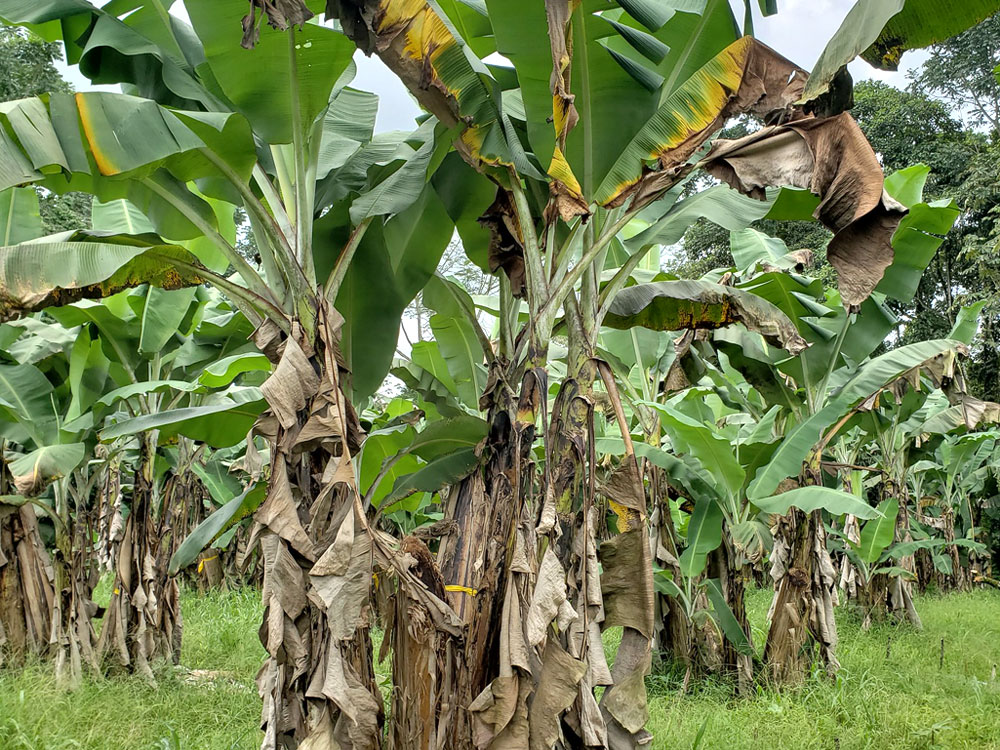
If your palm becomes infected with Fusarium wilt, you’ll notice a dark brown or reddish strip along the leaf stem. Additionally, the oldest leaves will start turning brown on one side of the leaf stem.
Once all the old leaves have turned brown, Fusarium wilt advances to the new emerging fronds. It can take anywhere from a few months to a few years for the palm to succumb to Fusarium wilt and die.
Unfortunately, there’s no remedy for this disease. The best preventive measure is to disinfect your tools to prevent its spread from tree to tree.
20. Ganoderma Butt Rot
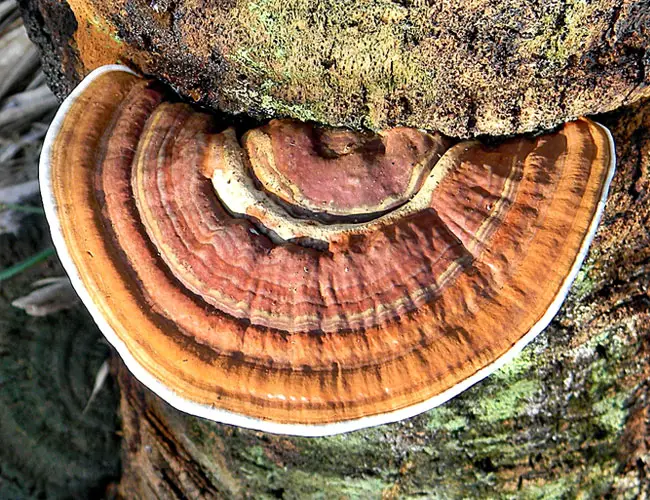
Ganoderma Butt Rot is a lethal disease caused by a fungus. It affects the lower portion of the palm’s trunk, hence its name Ganoderma Butt Rot. Detecting it can be tough because there aren’t many symptoms to watch for.
This disease silently eats away at the trunk tissue from the inside, forming a white spongy growth that turns brown as it matures. The fungal growth contains millions of spores that spread from tree to tree via the wind.
Sadly, there’s no cure for this disease. The only option is to remove the affected palm. First, cover that fungal conk with plastic to prevent spore spread. Then, dispose of the tree. Remember, Ganoderma can linger in the soil, so avoid planting anything in the same spot.
21. Bud Rot
Phytophthora bud rot is a common disease that strikes during hot, wet summers following tropical storms, heavy rain periods, or in palms severely damaged by freezing temperatures.
If your palm is suffering from bud rot, the new fronds will discolor and start wilting, and this can happen to the next set of new leaves as well.
Sometimes, you might spot black lesions on the new spears. Check if the new fronds come out easily. You might also notice a foul odor emanating from the bud.
In its early stages, if the damage isn’t too severe, you can try saving the palm by drenching the bud with fungicide. Whenever possible, avoid overhead irrigation.
22. Sooty Mold
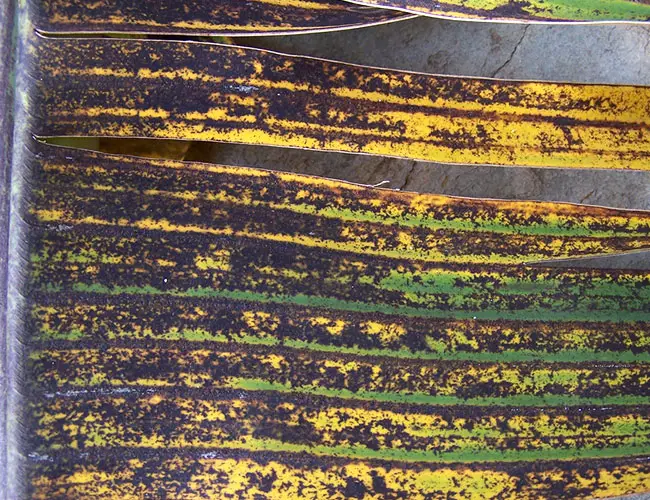
This superficial fungus doesn’t directly harm the plant but appears on the tree’s surface. It thrives on honeydew produced by palm aphids, mealybugs, or scale insects infestations.
Usually, it forms a black coating on the leaves that washes off easily. To prevent the development of Sooty Mold, manage honeydew-producing insects.
23. False Smut
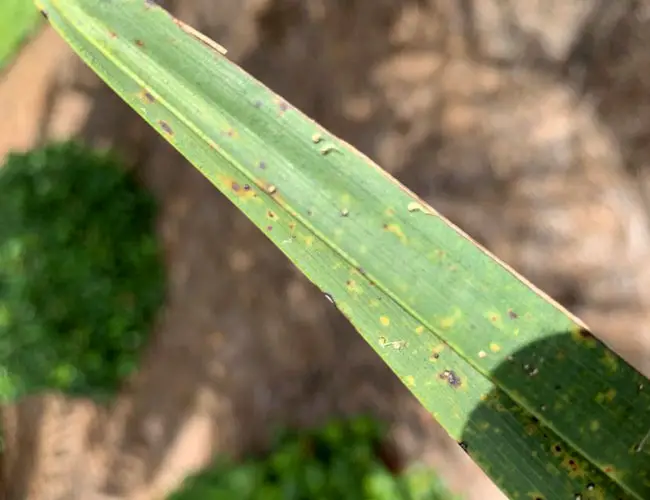
Another leaf fungus disease that affects palms under stress from overwatering or poor drainage is False Smut, also known as Graphiola leaf spot.
It initially manifests as yellow, brown, or black spots on both sides of the leaves. Older leaves are typically affected first. The fungus develops from these spots, producing yellow spores as it matures.
Primarily a cosmetic issue, it can be prevented by removing the affected leaves. You can also apply copper-based fungicides in the early stages to the remaining foliage to halt its spread.
Typically, it requires multiple applications throughout the year to eliminate it. The most commonly affected palms are Phoenix species, especially the Canary Island Date Palm and Date Palm.
24. Palm Leaf Skeletonizer
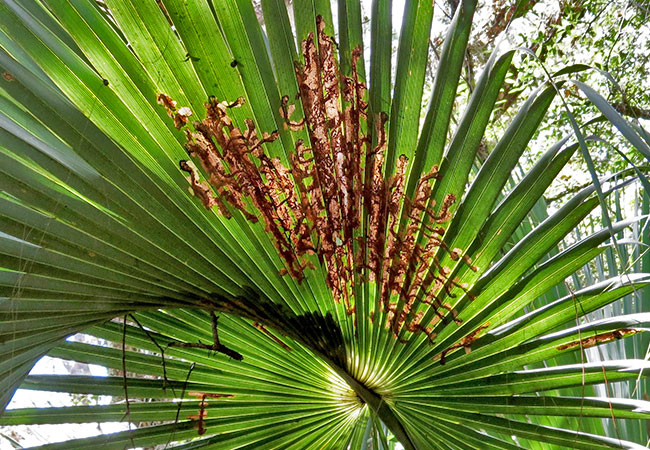
The palm leaf skeletonizer is the caterpillar of a small moth that feasts on both surfaces of palm leaves, leaving behind fibrous excrement known as “frass.”
They have a preference for munching on the tissue between the veins or ribs, creating a dark tube-like skeleton structure, hence their name, Leaf Skeletonizer.
These pests chew away at the palm leaves between the veins or ribs, giving rise to a dark tube-like structure that resembles a leaf skeleton.
Controlling this insect can be quite challenging. When spotted, remove the infected fronds and treat the rest with an insecticide containing carbaryl or a biological insecticide.
25. Palm Aphid
Palm aphids are stationary, dark brown bumps that feed on the newest growth of palm trees. They infest palms in large numbers, producing honeydew, which attracts ants. Ants consume the honeydew while protecting the aphids.
Infected palms display dark brown bumps with a white wax ring around them. Palm aphids can attack various palm species, but they are often found on Alexander Palms, Date Palms, Chinese Fan Palms, Coconut Palms, and Washington Palms.
To control palm aphids, insecticidal soap or horticultural oil can be effective, but you may need to reapply them multiple times.
26. Mealybugs

Numerous species of mealybugs can target palm trees. While some feed on the roots and are challenging to detect, most concentrate on the palm bud, where new fronds emerge.
Similar to palm aphids, they produce honeydew, which attracts sooty mold fungus and ants. On an infected palm, you’ll notice cottony white masses covering the new fronds and stems.
You can slow them down by applying a mixture of soapy water and alcohol. To completely eradicate mealybugs, spray the palm with insecticidal soap.
27. Palmetto Weevil
The Palmetto Weevil is a large beetle primarily attracted to severely stressed palms. However, a study from the University of Florida revealed that it could also attack entirely healthy palms. Some of its targets include Cabbage Palms, Canary Island Date Palms, Bismarck Palms, and Latan Palms.
This beetle, which can be black or sometimes red, lays its eggs in the leaf base of the palm. The eggs hatch, and the larvae start feeding on the plant, eventually making their way to the palm’s heart.
They destroy the bud and create cocoons from which adult weevils emerge. Diagnosing this problem early can be challenging, but if you do, treat the palm with insecticidal soap.
28. Saddleback Caterpillar
The Saddleback Caterpillar is a dark brown caterpillar with poisonous spines and a distinctive bright green pattern on its back that resembles a saddle. It creates large holes while feeding on the undersides of palm leaves.
You can manage young caterpillars with biological insecticides. Be sure to wear gloves to protect your hands from the spines.
It primarily targets palms like Christmas Palms, Butterfly Palms, Alexander Palms, Fishtail Palms, Coconut Palms, Princess Palms, Butterfly Palms, Mazari Palms, Canary Island Palms, Pygmy Date Palms, Queen Palms, and Mexican Fan Palms.
29. Scale Insects
Scale insects are a fairly common issue that can occasionally be found on palm leaves. There is a wide variety of scale insects, including Florida red scale, thread scale, Magnolia white scale, and soft brown scale. These small, legless, brown bumps target new growth, extracting fluids from it.
The most effective way to control them is by using horticultural oil, which needs to be reapplied multiple times to effectively eliminate them.
30. Spider Mites
Spider mites might sound like they belong to the spider family, but in reality, they’re tiny arachnids that belong to the Tetranychidae insect family, boasting an impressive 1,200 different species.
These tiny critters nibble on plant leaves and stems, sipping away at the sap. What’s tricky is how swiftly they multiply, setting up whole colonies in just weeks. They lay eggs beneath delicate silk webbing, and soon enough, you’ll have thousands of baby spider mites congregating on a single leaf.
Detecting these minuscule invaders can be quite the challenge due to their size. However, early detection is crucial because these pests are prolific reproducers and can swiftly spell doom for your plants.
If you spot spider mites on your palms, swift action is the name of the game to rescue your plants from their clutches.
One effective way to vanquish these invaders is by concocting a solution of regular dish soap and water, then giving your palm a good spray-down.
Related articles:
–Top 10 Palm Tree Care Mistakes and How To Avoid Them
–Top 10 Palm Tree Planting Mistakes You Don’t Want To Make
–5 Most Common Nutrient Deficiencies In Palms (with Pictures)
–Expert Tips: How And When To Fertilize Palm Trees
–5 Steps To Saving Freeze Damaged Palm Tree

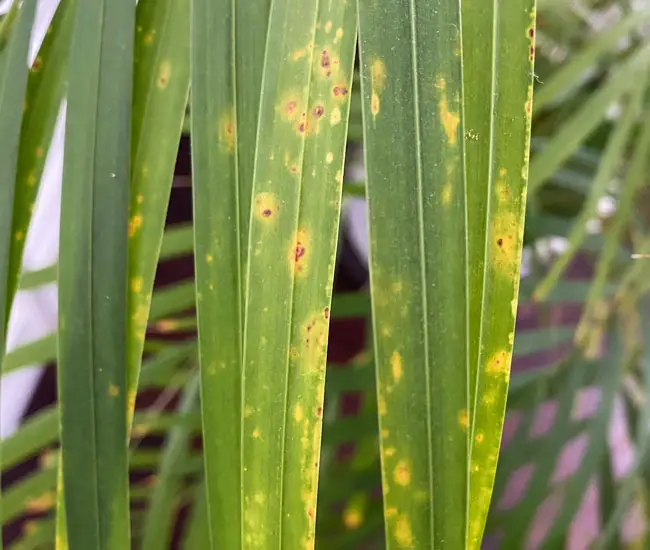
Thank you for such a great article my queen palms will do much better. I learned some key things such as not to over prune, freeze pruf…I use cloud cover here in California but haven’t tried it on my palms. Do you know if it would be equivalent to freeze pruf? Thanks for all your great info!
Thank you for all this information. I feel like my palms suffered from all of the above. Not sure where to start. Is it possible I could take some pictures and send them to you and you help figure a starting point to revive my palms or should I just toss them?
Thanks! I know my palm will do much better soon!
My palms trunk appears to be very damp, the leaves tat have fallen off or have been cut some time back can be easily pulled right off the tree. And it is very damp on this part of the trunk. Also, not sure what it’s called but it looks like a covering or hair on trunk. Falls out easily and under it is damp. Also ants under this. Is this normal? Please help!
A neighbor cut a fan palm trunk, leaving the roots in the ground. Can this plant be saved? I have kept most of the plant wet since my rescue.
Thanks!
Hi Katrin,
I am really glad to have found out your website.
Since I bought my house in Hollywood, Florida I thought to have a couple of Royal Palms at the front yard.
After some research on the nurseries around my location, I bought two beautiful Royals Palm of about 20′.
Install them was a nice experience, I never had palms like these. I was very happy.
I was so excited that I did not paid too much attention to some details, the nursery’s owner and the crew were doing their job so, I just followed their directives and comments. .
I remember they dig out two big holes where they had to break rock or clay I do not know really, but for sure it was not soil or sand. They planted my Royals on a clay rock bed. Without adding any fertilizer at the bottom. Very basic installation.
The owner said to me: Fernando to have to water them for 6 month, 3 times a week and leave them to grow.after. Which I did .
After 6 months I stopped watering my palms based on the nursery’s owner advice and after sometime they started to decay by getting yellow leaves, no new young branches, etc.
I thought what is happening? I did was the guy told me and now my palm are fine and growing by themselves, they are getting water from the ground. But I was Wrong ! They were not getting water underground because the type of soil (rock) did not allow it
After my watering for 6 months they started to die without enough water. It took me several months to realize the real problem and started again with the exterior water supply and they began recovering.
I know my palms roots are not getting water in the right regular way because the clay rock is blocking their access down below.
I also know too that nursery’s guy knew about this soil condition and did not say nothing to avoid abort the business.
My question today based on your experience is What will happen with the palm roots. will they find their own source of water underground or will they need be watering for ever?
They receive water from my irrigation system every day and manually by hose, three times a week ( 30 min each) .
Is there any way to bring water directly to the roots ?
I am looking to get information for this particular case I have.. I think a special irrigation system to the palm root is possible.
Thank you for attention
Fernando
My parotous palm are slowly dying ..
They have been in the ground for 12 years.. the really tall one are dying..
Any ideas? others In the group are doing fine or at least look fine… I live in ft pierce Florida…
Since I reported my medjool date palm the leaves have folded up like a straw. Can this be fixed, l spent 5 years going this from seed.
My 40+foot 20 year old palm tree was over pruned by my bad choice of workers.No new growth since.Is there anything I can do except wait and hope..
Live in NYC.. Wrapped tree with Christmas mini lights and burlap and garden bag.. Unwrapp ed tree and most leaves totally dried out. Can it come back?
Boston ferns are growing on my palms stem. Will that hurt the palm?
Bought this tall indoor cane palm and it’s in a sunny room, but some end bits look dry and turning brown , any advice ?
This is a fantastic article! Well written and informative.
I believe our majestic 50+ year old canary date palm was recently shocked by a nearby lightning strike. It was fine and now all of a sudden the finds are wilting and the bud is exposed.
We lost a TV, security system and cable box in the same time frame. All the equipment is within 20 feet of the tree.
We we’ll file your advice and spray the fungicide. In your opinion, how long will it take for us to know more about if the tree will survive our not?
Thanks again! Robin
I will be watching this article for updates and answers. Thanks again!
Hi . I have an indoor travelers palm but its not feel well . and its new leave is somthing between yellow and light brown . and small leaf eadges turned insid . i newly bring it from other city . is it possible that the oroblem be a moving to new home . and if its what should i do . thanks
I HAVE 2 WINDMILL PALM TREESBOTH ARE ABOUT 10 YEARS OLD ONE IS LOOKING REAL BAD IT HAS NO NEW GROWTH ON IT WHERE THE NEW COMES OUT OF THE TOP IS SOME REAL HARD MASS LOOKING GROWTH IT WAS LOOKING FINE UNTILL ABOUT A MONTH AGO DO YOU KNOW WHAT IT IS AND IF SO WHAT CAN I DO ABOUT IT
My palms did shoot out the top like usual and dlowly they turned half btown. Can someone help.
My palms trees had very little Palm growth they did not shoot out much this year. Turned brown quick. I live in Fort Worth tx
I think it’s interesting how you said that when you over-prune your palm tree, or use the wrong kind of fertilizer or soil, it can damage the tree and cause it to lose nutrients. I had no idea that so much care was required for palm trees! My husband and I moved into a home with palm trees in the backyard, but we want to take care of them correctly, we just don’t know how. I’ll have to look for a palm tree maintenance service in our area that can use their experience and skills to prune our trees adequately, so that they last us a long time.
Can i save my 5mo old 5’ tall Pindo? Apparently its not draining the soild good enough. The first yellow fromd coming up and fromds starting to fall from center. Will raising and adding sand save it?
Hello,
Trying to save my Adonidia Palms. They are in a greenhouse in Northern NJ which is heated. Temps range from 35 deg at night to 85 deg in the day. I water them once per week. Leaves are now all brown. Even a new bud is now brown. do they have any chance to survive until spring?
My Christmas palm developed a condition where the fron from one of the trunks started to die before it naturally did it’s self cleaning and then one day the whole top of the one trunk just fell off. My husband cut that trunk off and we thought everything would be ok. Now a couple of months later the same premature fron dying is starting on a second trunk. What is wrong with my tree and how should it be treated?. This tree is about 13 years old and has been very beautiful.
Two years in a row, my bottle palms have been ravaged by winter. By the end of winter, I am sure the plant is dead, but then it spits out a few dead fronds in spring, and starts growing very small but healthy new fronds in summer. By winter they are almost back to the size they were when I bought them on sale not knowing what they were. It almost looks like the trunk\crown is dead and that a totally new plant is growing out of the old roots. Obviously, I need to work on winter protection, but in the mean time I’ve been told that the new growth would fair better in the shade. Is this true? If so, I can put my potted king palm next to it.